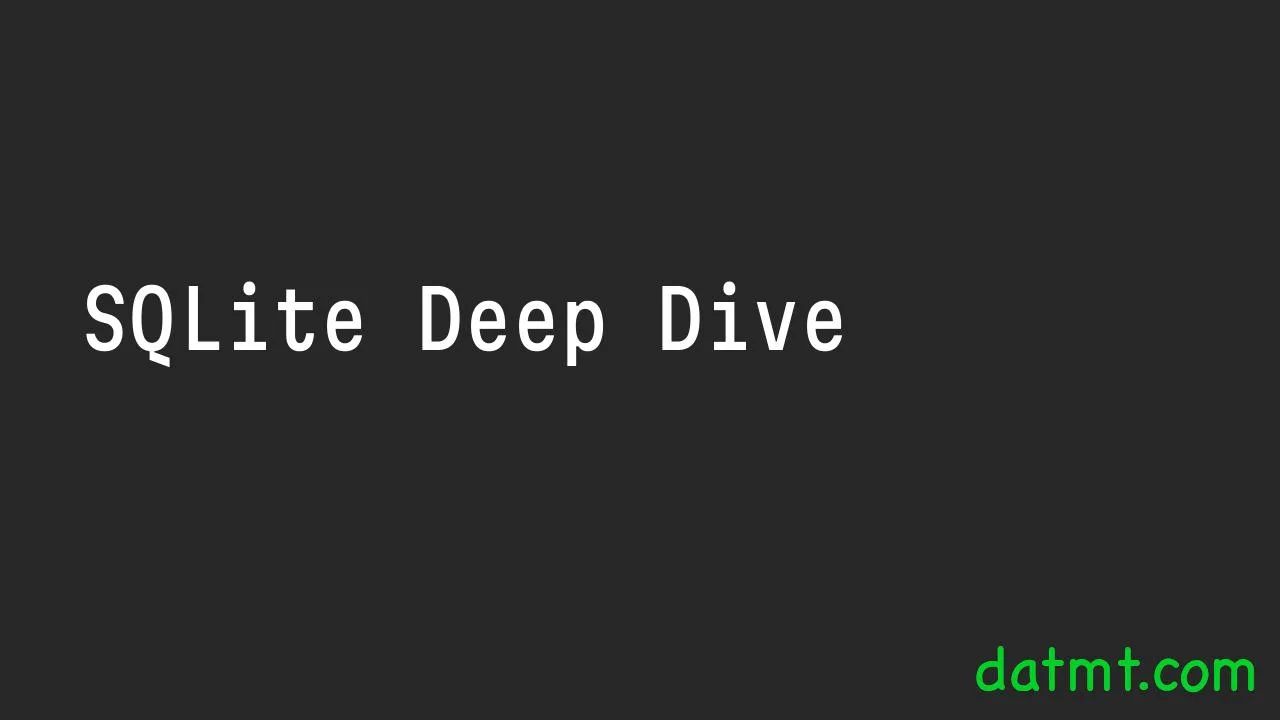Table of Contents
- 1 Overview
- 2 What is SQLite?
- 3 Key Concepts
- 3.1 ACID
- 3.2 B-Tree
- 3.3 Blob
- 3.4 Client-Server Database
- 3.5 Concurrency Control
- 3.6 Cost-Based Query Planner
- 3.7 Dynamic Type System
- 3.8 Embedded System
- 3.9 Exclusive Lock
- 3.10 Fsync
- 3.11 Index
- 3.12 Journal File
- 3.13 Open Source
- 3.14 Page
- 3.15 Public Domain
- 3.16 Query Plan
- 3.17 Rollback
- 3.18 Serverless
- 3.19 Shared Lock
- 3.20 SQL
- 3.21 SQLite
- 3.22 Transaction
- 3.23 Tuple
- 3.24 WAL (Write-Ahead Logging)
- 4 Questions and answers
- 4.1 What makes SQLite an “embedded” database engine?
- 4.2 Explain the key difference between rollback journaling and write-ahead logging in SQLite.
- 4.3 Describe how SQLite stores data on disk, focusing on the role of B-trees.
- 4.4 What is the purpose of the sqlite_schema table in an SQLite database?
- 4.5 Briefly outline the steps involved in the execution of an SQL statement in SQLite, highlighting the role of the virtual machine.
- 4.6 What is unique about SQLite’s handling of data types in tables?
- 4.7 Explain the purpose and benefits of SQLite’s query planner.
- 4.8 How does SQLite determine the optimal order of joins in a complex query?
- 4.9 Describe the approach SQLite takes to ensure security against malicious SQL statements or database files.
Overview
This blog post is a summary of the following talk on YouTube, credits to the presenter.
What is SQLite?
SQLite is a widely used, serverless, and self-contained database engine known for its simplicity, speed, and reliability. Its key features contribute to its popularity and versatility across various applications.
Ease of Use and Deployment
- Serverless Architecture: SQLite operates directly within the application, eliminating the need for a separate server process. This simplifies deployment and enhances the robustness of applications.
- Single File Database: The entire database resides in a single file, making it highly portable and shareable. It can also serve as an application file format.
- Open Source and Public Domain: SQLite is free to use for any purpose without licensing restrictions, fostering widespread adoption and community development.
Performance and Reliability
- Speed: SQLite is exceptionally fast, sometimes outperforming direct file system access for reading data. This is partly attributed to reduced overhead from opening and closing files repeatedly.
- Transactions: SQLite utilizes atomic transactions, ensuring data consistency even in cases of application crashes or power outages. This mechanism preserves data integrity and prevents corruption.
- Concurrency: While SQLite allows one writer at a time, it supports multiple concurrent readers. This caters to many applications where read operations are more frequent.
Other Notable Features
- SQL Support: SQLite provides a powerful SQL query language for efficient data search and manipulation. This enables complex data retrieval and analysis within applications.
- B-tree Data Structure: SQLite employs a B-tree data structure for data storage, including tables and indexes. This structure facilitates efficient data access and retrieval.
- Cost-Based Query Planner: SQLite optimizes query execution by estimating the cost of different execution plans. This ensures queries are performed in the most efficient way possible.
- Dynamic Type System: SQLite does not enforce strict data types for columns. This offers flexibility but requires careful consideration when interacting with databases with stricter typing systems.
Limitations
- Limited Concurrency for Write Operations: Only one writer can operate at a time, which could be a bottleneck for write-intensive applications.
- Limited Feature Set: SQLite lacks features found in some other SQL databases, such as stored procedures and triggers. However, extensions are available to address some of these limitations.
- Network File System Performance: While SQLite can work across network file systems, performance is suboptimal, and potential locking issues can arise.
SQLite’s robust features and ease of integration have led to its widespread use in devices ranging from smartphones and computers to cars and airplanes. Its small footprint and efficient performance make it a preferred choice for embedded systems and applications requiring a lightweight and reliable database solution.
Key Concepts
ACID
A set of properties that guarantee database transactions are processed reliably. It stands for Atomicity, Consistency, Isolation, and Durability.
B-Tree
A self-balancing tree data structure that enables efficient searching, insertion, and deletion of data in a sorted order.
Blob
Binary Large Object, a data type used to store large amounts of binary data in a database.
Client-Server Database
A database system where a server process manages the database and client applications connect to it to access data.
Concurrency Control
Mechanisms that manage simultaneous access to a database by multiple users or processes, ensuring data integrity and consistency.
Cost-Based Query Planner
A component of a database management system that analyzes queries, estimates the cost of different execution plans, and chooses the most efficient plan.
Dynamic Type System
A type system where data types are checked at runtime, allowing for flexibility but potentially increasing the risk of runtime errors.
Embedded System
A computer system designed for specific control functions within a larger system, often with limited resources.
Exclusive Lock
A lock that prevents any other process from accessing a resource until the lock is released.
Fsync
A system call that forces all buffered data to be written to the physical storage device, ensuring data durability.
Index
A data structure that speeds up data retrieval by providing a quick lookup mechanism based on specific columns.
Journal File
A file used to record changes to a database before they are committed, allowing for rollback in case of failures.
Open Source
Software whose source code is publicly available and can be modified and redistributed freely.
Page
A fixed-size block of data used in database storage systems for managing data on disk.
Public Domain
Works that are not protected by copyright and can be used freely for any purpose.
Query Plan
A step-by-step strategy for executing a database query, often generated by a query planner.
Rollback
Reverting a database transaction to its previous state, undoing any changes made during the transaction.
Serverless
An architecture where applications run without needing to manage their own servers, relying on cloud services to provide backend functionality.
A lock that allows multiple processes to read a resource but prevents writing until the lock is released.
SQL
Structured Query Language, a standardized language used to manage and manipulate data in relational databases.
SQLite
A lightweight, serverless, embedded SQL database engine known for its portability and ease of use.
Transaction
A unit of work in a database, consisting of one or more database operations, that is treated as a single, indivisible operation.
Tuple
A row of data in a relational database table.
WAL (Write-Ahead Logging)
A method of concurrency control that logs database changes in a separate file, providing higher concurrency and speed.
Questions and answers
Before you begin, it’s good to check your knowledge with the following questions and answers
What makes SQLite an “embedded” database engine?
SQLite is embedded because the database engine is part of the application itself, not a separate server process. This means the application directly interacts with the database file on disk.
Explain the key difference between rollback journaling and write-ahead logging in SQLite.
Rollback journaling creates a separate file to store original page content before modifications, facilitating rollback. WAL logs all changes in a separate file, allowing concurrent reads and potentially faster write performance.
Describe how SQLite stores data on disk, focusing on the role of B-trees.
SQLite stores data in a series of pages organized into B-trees. Each table and index is represented by a B-tree, and data is stored in the leaf nodes of these trees for efficient retrieval.
What is the purpose of the sqlite_schema table in an SQLite database?
The sqlite_schema table acts as a central directory for the database. It stores information about tables, indexes, triggers, and views, including their root page location, schema definition, and associated SQL statements.
Briefly outline the steps involved in the execution of an SQL statement in SQLite, highlighting the role of the virtual machine.
An SQL statement is first parsed and transformed into bytecode by the code generator. This bytecode is then executed by the virtual machine, which interacts with the lower layers of SQLite (B-tree, pager) to retrieve and manipulate data.
What is unique about SQLite’s handling of data types in tables?
SQLite doesn’t enforce strict data typing on columns. You can insert any data type into a column, regardless of its declared type. SQLite attempts to perform type conversions if needed for compatibility but prioritizes flexibility.
Explain the purpose and benefits of SQLite’s query planner.
The query planner analyzes SQL statements and generates an execution plan that aims to minimize the cost of retrieving the requested data. This involves choosing appropriate indexes, determining join order, and applying various optimizations.
How does SQLite determine the optimal order of joins in a complex query?
SQLite uses a cost-based approach, generating various join order permutations and evaluating their cost based on factors like table size, index availability, and estimated selectivity. It aims to find the join order with the lowest overall cost.
Describe the approach SQLite takes to ensure security against malicious SQL statements or database files.
SQLite employs extensive fuzzing and testing to ensure robustness against malformed SQL queries and database files. It guarantees no memory errors will occur, though long-running queries could potentially be used for denial-of-service attacks.

I build softwares that solve problems. I also love writing/documenting things I learn/want to learn.
